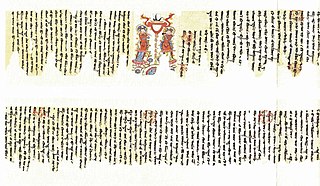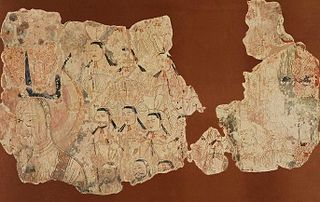
Manichaeism was a major religion founded in the 3rd century AD by the Parthian prophet Mani, in the Sasanian Empire.

The Manichaean script is an abjad-based writing system rooted in the Semitic family of alphabets and associated with the spread of Manichaeism from southwest to central Asia and beyond, beginning in the 3rd century CE. It bears a sibling relationship to early forms of the Pahlavi script, both systems having developed from the Imperial Aramaic alphabet, in which the Achaemenid court rendered its particular, official dialect of the Aramaic language. Unlike Pahlavi, Manichaean script reveals influences from Sogdian script, which in turn descends from the Syriac branch of Aramaic. Manichaean script is so named because Manichaean texts attribute its design to Mani himself. Middle Persian is written with this alphabet.

The Dunhuang manuscripts are a cache of important religious and secular documents discovered in the Mogao Caves of Dunhuang, China, in the early 20th century. Dating from late 4th to early 11th centuries, the manuscripts include works ranging from history and mathematics to folk songs and dance. There are also many religious documents, most of which are Buddhist, but other religions including Daoism, Nestorian Christianity and Manichaeism are also represented. The majority of the manuscripts are in Chinese. Other languages represented are Khotanese, Kuchean, Sanskrit, Sogdian, Tangut, Tibetan, Old Uyghur language, Prakrit and Old Turkic. The manuscripts are a major resource for academic studies in a wide variety of fields including history, religious studies, linguistics, and manuscript studies.

Cao'an is a temple in Jinjiang, Fujian. Originally constructed by Chinese Manicheans, it was considered by later worshipers as a Buddhist temple. This "Manichean temple in Buddhist disguise" is seen by modern experts on Manichaeism as "the only extant Manichean temple in China", or "the only Manichean building which has survived intact".
Chinese Manichaeism or ‘Religion of Light’ known as Monijiao (Chinese: 摩尼教; pinyin: Móníjiào; Wade–Giles: Mo2-ni2 Chiao4; lit. 'religion of Moni') or Mingjiao (Chinese: 明教; pinyin: Míngjiào; Wade–Giles: Ming2-Chiao4; lit. 'religion of light' or 'bright religion'), is the form of Manichaeism transmitted and practiced in China. It rose to prominence during the Tang dynasty and, despite frequent persecutions, continued long after the other forms of Manichaeism were eradicated in the West. The most complete set of surviving Manichaean writings were written in Chinese sometime before the 9th century and were found in the Mogao Caves among the Dunhuang manuscripts.

Seven Sutras of Manichaeism are seven scriptures personally written by the founder of Manichaeism Muni and are the fundamental classics practiced by Manichaeism.
The Epistles, one of the Seven Treatises of Manichaeism. It is derived from the Middle Ancient Persian "dēwān", which means ""'Letter Collection"'".

Sogdian-language Manichaean letter is a Sogdian letter written by Mani to Mu Wei of the Eastern Diocese, found in Xinjiang Baziklik Thousand-Buddha Caves, selected National Precious Ancient Books. Now in the collection of Turpan Museum, number "81 TB 65:01".

The Chinese Manichaean hymn scroll is a scroll found by British Archaeologist Aurel Stein found in the Mogao Grottoes Tang Dynasty Grottoes of Dunhuang, as Manichaeism Dunhuang Chinese triple one, is the ancient Chinese Manichaean Hymns used by Christians in religious ceremonies. Now in the collection of the British Library, number S.2659。

The Manichean Compendium, was found in the Mogao Cave Tibetan Scripture Cave of Dunhuang is a manuscript expounding the doctrine of Manicheaism, which was born in the reign of Emperor Xuanzong of Tang by the Persian missionary Fuduo Written in the nineteenth year of his reign (731), it briefly summarizes the basic teachings and rituals of the religion, and is an introductory document for understanding Manichaeism.

Incomplete scripture of Manichaeism, was discovered by British archaeologist Aurel Stein in Mogao Caves Tibetan The Tang Dynasty Manichean Posthumous Manuscripts of Jingdong is one of the Manichaeism Dunhuang Chinese Three Classics. Now in the collection of National Library of China, number BD00256.

In Manichaeism, Jesus is considered as one of the four prophets of this religion, along with Zoroaster, Gautama Buddha and Mani is also a "Guiding deity" who greets the light bodies of the righteous after their deliverance. 3:352

Manichaean Temple Banner Number "MIK Ⅲ 6286" is A Manichaean monastery flag banners collected in Germany Berlin Asian Art Museum, made in the 10th century AD, and was German Turpan expedition team at the beginning of the 20th century Found in Xinjiang Gaochang. The flag streamer is 45.5 cm long and 16 cm wide, with painted portraits on both sides. It is a funeral streamer dedicated to the deceased Manichae believers.

Sanyi Religion in the Tang Dynasty refers to the three religions that originated in Persia that were spread in China during the Tang period. They were recognized and protected by the Tang Dynasty and prospered for a while.
The letter of the last thought, also known as ``'Sisinnius, One of the twelve Apostles of the founder of Mani, one of the most influential Manichaeans in the early church, the core figure of the early church, The first Manichaean Pope.
Mar Adda, was One of the twelve Apostles of Mani, the founder of Manichaeism, the year of birth and death is unknown.

The Xiapu Manichean Manuscripts were Manuscripts found in October 2008 Shangwan Village, in Baiyang Borough, Xiapu County, Fujian Province.

Leaf from a Manichaean book MIK III 4974 is a fragment of Manichaean manuscripts collected in Germany Berlin Asian Art Museum, drawn in the 10th century, 20 At the beginning of the century, it was discovered by German Turpan expedition team in Xinjiang Gaochang Ancient City. The remaining page is 7.9 cm long and 15.5 cm wide, with an illuminated manuscript illustration drawn in the center of the front. The upper part of the book is written with Middle Persian Benediction The scriptures indicate that this fragment originally belonged to a Manichae Liturgical book.

Leaf from a Manichaean book MIK III 6368 is a fragment of Manichaean manuscripts collected in Germany Berlin Asian Art Museum, drawn during the 8th-9th centuries, Was discovered in Xinjiang by German Turpan expedition team in the early 20th century. The remaining page is 8.2 cm long and 11.0 cm wide, with slender painting illustrations on both sides, and the text is Sogdian.

Fragment of Manichaean Wall Painting "MIK Ⅲ 6918" is a fragment of a mural Manichaeism collected in Germany Berlin Asian Art Museum, painted around the 10th century AD, and was German Turpan expedition team found in the ruins of Gaochang in Xinjiang. The fragment is 88 centimeters long and 168.5 centimeters wide. It depicts a scene of worship in a Manichae church.